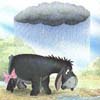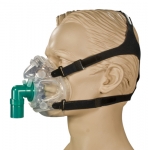Can ASV cause fatigue? Need BiPAP instead?
Re: Can ASV cause fatigue? Need BiPAP instead?
A secondhand BiPAP will set you back a lot less than a DS960 unless your insurance is footing the whole bill.
- justinjustin
- Posts: 119
- Joined: Sun Oct 06, 2013 11:38 pm
Re: Can ASV cause fatigue? Need BiPAP instead?
I have no insurance, but I could try secondhand BiPAP.cnaumann wrote:A secondhand BiPAP will set you back a lot less than a DS960 unless your insurance is footing the whole bill.
So it's common that even with BiPAP, the flow curve gets all ratty? If you see my earlier examples, the only time my curves are consistently nice is when I'm at a stable 18cm. The ASV always wakes me up.
_________________
| Mask: Mirage Quattro™ Full Face CPAP Mask with Headgear |
| Humidifier: S9™ Series H5i™ Heated Humidifier with Climate Control |
| Additional Comments: Complex Sleep Apnea, mainly CSA, with UARS. RDI of 30 w/o xPAP. |
Re: Can ASV cause fatigue? Need BiPAP instead?
I'll swap you a vauto for your adapt.justinjustin wrote:I have no insurance, but I could try secondhand BiPAP.cnaumann wrote:A secondhand BiPAP will set you back a lot less than a DS960 unless your insurance is footing the whole bill.
So it's common that even with BiPAP, the flow curve gets all ratty? If you see my earlier examples, the only time my curves are consistently nice is when I'm at a stable 18cm. The ASV always wakes me up.
Get OSCAR
Accounts to put on the foe list: dataq1, clownbell, gearchange, lynninnj, mper!?, DreamDiver, Geer1, almostadoctor, sleepgeek, ajack, stom, mogy, D.H., They often post misleading, timewasting stuff.
Accounts to put on the foe list: dataq1, clownbell, gearchange, lynninnj, mper!?, DreamDiver, Geer1, almostadoctor, sleepgeek, ajack, stom, mogy, D.H., They often post misleading, timewasting stuff.
Re: Can ASV cause fatigue? Need BiPAP instead?
There are people who sometimes chronically hyperventilate during the daytime.cnaumann wrote:Interesting stuff, Todzo, I am responding because I want to read those links in depth at a later time.
I have really ratty breathing at night. Actually, I did a little experiment yesterday and turned the pressures on my machine all the way down and breathed through it while awake and watching TV for a couple of hours. Turns out I have pretty ratty breathing while I am awake as well. I don't have any apneas while awake (I don't go over 10 seconds without breathing), but my awake breathing does not seem to fit any regular pattern. I will go for 15 minutes breathing slow and deep (RR around 8 ), then go for a while breathing faster and shallower (RR around 14). My breaths don't really seem to be regularly spaced. I have no idea if this is normal or very unusual.
I found myself doing that as a result of stress at times. Breathing reflexes appear to vary with life.
I do not recall seeing anything like this in any literature. Could you provide a citation?cnaumann wrote:I believe that the current thinking is that centrals don't cause the arousal that obstructives do, and therefore they do not interfere with sleep as much.
What I do find is that a “ratty” flow waveform consistently results in less productivity and symptoms of tiredness the next day. This is likely this due to the excessive breathing during the wide parts of the flow waveform (the kind of breathing which can reduce the blood CO2 levels below the apneic threshold) resulting in respiratory effort above my arousal threshold. I sometimes note less productivity and more tiredness with a “ratty” flow waveform even if no “Clear Airway” (apparently hypocapnic central apneia) events are flagged.
The interplay between ventilatory gain, arousal threshold, along with possible thus induced obstruction is a complex dance indeed.
Please do reference where you saw this.cnaumann wrote: You don't actually have to 'wake up' to deal with a central, as you do with an obstructive.
If you are hyperventilating why would your O2 levels show low?cnaumann wrote: So in spite of low O2 levels
Considering the way the brain rejects such blood[1] and the fact that most recent research seems to point to blood circulation issues as being related to the brain damage associated with OSA[2] I do believe I would be concerned about the CO2 level going below the apneic threshold.cnaumann wrote: and decreased blood pH, they may not be as damaging, or at least they are not damaging in the same way.
I would expect the better carbon dioxide maintenance to help greatly with SpO2 levels measured at the fingertip as well as facilitating better circulation in your brain and ears. Very good news.cnaumann wrote:I have been doing ASV for only two nights now. It is definitely keeping my spO2 levels up (I can measure that) and I have not had a headache or ringing in my ears either morning as I typically do (might be due to the therapy, but could be anything).
And there is the rub!!cnaumann wrote: The pressure changes are waking me up,
I believe that trying to manage ventilatory gain issues with changes in pressure simply cannot be done without causing arousals.
So the brain can live a bit happier (due to the better facilitated circulation and metabolism resulting from the better carbon dioxide maintenance) but without consistent sleep your brain will not work as well as someone who gets consistent sleep. If the machine fractures your sleep your performance will still be compromised.
If you think soda bottles and duct tape are a reasonable path to EERS you should not try it. I did so with my doctors blessing and guidance. Indeed the parts used in the study referenced[3] are “off the shelf” and could be ordered by your doctor.cnaumann wrote: I am hoping that I will 'settle in' after a while. The idea of just CPAP to keep my airway open and re-breathing some CO2 to keep my brain from stopping respiration is interesting. I may have to get some soda pop bottles and duct tape and try it.
Currently I have added a little 3-4 lpm bleed to my EERS near the lossy mask vent point (original). This facilitates very very little re-breathed air if my breathing levels are what they should be at rest and in bed with re-breathed air added only when the air volumes and respiratory rates increase. This does seem to produce even more stable results and better daytime performance and feel.
For years I had improved results from varying my lifestyle to deal with issues I found in my CPAP data. I adjust pressure and use such as EERS only as a last resort.cnaumann wrote:As far as ASV fatigue and needing simple BiPAP, my own experience is that my breathing is quite stable during part of the night even without therapy, and all over the place at other times even with the ASV therapy. For me, I don't believe there is a magic BiPAP pressure setting that just works. A fixed pressure will work for a while, then things always go bonkers. Your mileage may vary.
For example eating better and working toward an active lifestyle (with some 10+ similar changes added in) has resulted in low AHI and stable sleep using 9.5 cm/H2O (7.5 works in the late spring to summer time) rather than the 15 cm/H2O which allowed low AHI and stable sleep several years ago. The new pressures are much easier to deal with and well worth the lifestyle changes I made to get there.
Chronotherapy[4] is still new to me but I am greatly encouraged thus far.
By using many things together to improve my health my mileage is getting better and better as I go.
[1] Philip N. Ainslie , James Duffin Integration of cerebrovascular CO2 reactivity and chemoreflex control of breathing: mechanisms of regulation, measurement, and interpretation
American Journal of Physiology - Regulatory, Integrative and Comparative Physiology Published 1 May 2009 Vol. 296no. 5, R1473-R1495DOI: 10.1152/ajpregu.91008.2008
[2] Yadav SK, Kumar R, Macey PM, Woo MA, Yan-Go FL, Harper RM. Insular cortex metabolite changes in obstructive sleep apnea. SLEEP 2014;37(5):951-958. Related article (commentary): 835
[3]: Gilmartin G, McGeehan B, Vigneault K, Daly RW, Manento M, Weiss JW, Thomas RJ.
Treatment of positive airway pressure treatment-associated respiratory instability with enhanced expiratory rebreathing space (EERS).
Source: J Clin Sleep Med. 2010 Dec 15;6(6):529-38. Division of Pulmonary, Critical Care and Sleep Medicine, Beth Israel Deaconess Medical Center, Boston, MA, USA.
Link: http://www.ncbi.nlm.nih.gov/pubmed/21206741
[4] http://www.amazon.com/Chronotherapy-Res ... B007P7HZUE
May any shills trolls sockpuppets or astroturfers at cpaptalk.com be like chaff before the wind!
Re: Can ASV cause fatigue? Need BiPAP instead?
This is somewhat off-topic here, but plastic bottles can be used as EERS:Todzo wrote:If you think soda bottles and duct tape are a reasonable path to EERS you should not try it. I did so with my doctors blessing and guidance. Indeed the parts used in the study referenced[3] are “off the shelf” and could be ordered by your doctor.cnaumann wrote: I am hoping that I will 'settle in' after a while. The idea of just CPAP to keep my airway open and re-breathing some CO2 to keep my brain from stopping respiration is interesting. I may have to get some soda pop bottles and duct tape and try it.


They were used even without CPAP for high altitude central apnea and periodic breathing treatment. See, for example:
"Dead Space Mask Eliminates Central Apnea at Altitude"
http://online.liebertpub.com/doi/full/1 ... .2012.1111
"Effect of added dead space on sleep disordered breathing at high altitude"
http://www.sleep-journal.com/article/S1 ... 3/fulltext
_________________
| Mask: Simplus Full Face CPAP Mask with Headgear |
| Additional Comments: Non Vented Mask + EERS (Enhanced Expiratory Rebreathing Space). Software: SleepyHead, ResScan, SpO2 Review |
Nov.2012: 1st sleep study OSA AHI=105
Feb.2013: Started APAP 10-20cm
May.2013: 2nd sleep study. CPAP 12cm + Non Vented Mask + EERS
Oct.2013: S9 VPAP Adapt 36037
May.2014: 3rd sleep study.
Experimenting with acetazolamide (diamox) 250mg
Feb.2013: Started APAP 10-20cm
May.2013: 2nd sleep study. CPAP 12cm + Non Vented Mask + EERS
Oct.2013: S9 VPAP Adapt 36037
May.2014: 3rd sleep study.
Experimenting with acetazolamide (diamox) 250mg
- justinjustin
- Posts: 119
- Joined: Sun Oct 06, 2013 11:38 pm
Re: Can ASV cause fatigue? Need BiPAP instead?
Does it work Buran?
Where does the hose to the CPAP go, attaching to the bottle?
Where does the hose to the CPAP go, attaching to the bottle?
_________________
| Mask: Mirage Quattro™ Full Face CPAP Mask with Headgear |
| Humidifier: S9™ Series H5i™ Heated Humidifier with Climate Control |
| Additional Comments: Complex Sleep Apnea, mainly CSA, with UARS. RDI of 30 w/o xPAP. |
Re: Can ASV cause fatigue? Need BiPAP instead?
naumann wrote:
You don't actually have to 'wake up' to deal with a central, as you do with an obstructive.
Please do reference where you saw this.
cnaumann wrote:
So in spite of low O2 levels
If you are hyperventilating why would your O2 levels show low?
I wish I could recall the reference. I have been reading a ton of stuff in the last two weeks and I cannot really the reference. Unfortunately, most of the 'good stuff' is either paywalled or too technical for me to understand.
Hyperventilating can make your O2 levels low. It does seem counter-intuitive. Here is what happens. Hyperventilating does NOT increase your spO2 levels, they can only go to 100% and should be in the high 90's anyway. It does not increase the amount of O2 in your lungs either, that stays a pretty constant 20%. What is does do is strip CO2 from your blood, increasing your blood pH. This reduces your urge to breath Your m, since your main urge to breath is from CO2 build-up (why EERS works) and not low O2. You remove the CO2, you remove the urge to breath. Then your spO2 levels plummet and you are none the wiser. There is a phenomena that hits experienced swimmers called shallow water drowning. Basically, the swimmer hyper ventilates either accidently or or purpose, and then passes out due to low O2 levels because they never got an urgent signal to come up and breath.
Soda bottles and duct tape are a very reasonable path to EERS. It is not exactly rocket science. Unlike oxygen depletion, you will get pretty paniced if you re-breath too much CO2. As long as you don't get too carried away with the volume there is not a lot that can really go wrong.If you think soda bottles and duct tape are a reasonable path to EERS you should not try it. I did so with my doctors blessing and guidance. Indeed the parts used in the study referenced[3] are “off the shelf” and could be ordered by your doctor.
Re: Can ASV cause fatigue? Need BiPAP instead?
No CPAP is needed Only the mask and EERS (they made a hole at the bottom of the bottle).justinjustin wrote:Does it work Buran?
Where does the hose to the CPAP go, attaching to the bottle?
(Also, zoom out to see the whole photo with a plastic cap)
As far as I know, this system (mask + EERS, no CPAP) is currently evaluated for high altitude central apnea or periodic breathing.
Before it also has been used (also without CPAP) for treating "ordinary" central apnea and periodic breathing with some success.
I believe, currently EERS for apnea treatment is ONLY used TOGETHER WITH CPAP/BiPAP/ASV. And in this case an extra short tube ("blue tube") together with "whisper swivel exhalation port" is used instead of a plastic bottle (see the presentation mentioned in my previous post).
_________________
| Mask: Simplus Full Face CPAP Mask with Headgear |
| Additional Comments: Non Vented Mask + EERS (Enhanced Expiratory Rebreathing Space). Software: SleepyHead, ResScan, SpO2 Review |
Nov.2012: 1st sleep study OSA AHI=105
Feb.2013: Started APAP 10-20cm
May.2013: 2nd sleep study. CPAP 12cm + Non Vented Mask + EERS
Oct.2013: S9 VPAP Adapt 36037
May.2014: 3rd sleep study.
Experimenting with acetazolamide (diamox) 250mg
Feb.2013: Started APAP 10-20cm
May.2013: 2nd sleep study. CPAP 12cm + Non Vented Mask + EERS
Oct.2013: S9 VPAP Adapt 36037
May.2014: 3rd sleep study.
Experimenting with acetazolamide (diamox) 250mg
Re: Can ASV cause fatigue? Need BiPAP instead?
I guess what you want is "BiPAP S/T" mode in Respironics ASV.justinjustin wrote: But I have a question: Does Respironics BiPAP autoSV allow you to set PSmin and PSmax to the same value? That would create a BiPAP-like setting.
I have a very limited experience (one week only and I had no software to monitor pressure waveforms) with Respironics ASV (now it is my back up machine).
But I hope somebody with more real life experience will clarify this. Specifically, can you set minPS=maxPS and still have back up rate? Hopefully next week I’ll have access to my Respironics ASV again and will test it myself.
Anyway, my point (see my initial post) was that even without setting minPS=maxPS, Respironics PS probably will not jump like PesMed PS (at least not for a long time periods), because they employed different algorithms.
_________________
| Mask: Simplus Full Face CPAP Mask with Headgear |
| Additional Comments: Non Vented Mask + EERS (Enhanced Expiratory Rebreathing Space). Software: SleepyHead, ResScan, SpO2 Review |
Nov.2012: 1st sleep study OSA AHI=105
Feb.2013: Started APAP 10-20cm
May.2013: 2nd sleep study. CPAP 12cm + Non Vented Mask + EERS
Oct.2013: S9 VPAP Adapt 36037
May.2014: 3rd sleep study.
Experimenting with acetazolamide (diamox) 250mg
Feb.2013: Started APAP 10-20cm
May.2013: 2nd sleep study. CPAP 12cm + Non Vented Mask + EERS
Oct.2013: S9 VPAP Adapt 36037
May.2014: 3rd sleep study.
Experimenting with acetazolamide (diamox) 250mg
Re: Can ASV cause fatigue? Need BiPAP instead?
The latest test version of sleepyhead will display the pressure waveform.I have a very limited experience (one week only and I had no software to monitor pressure waveforms) with Respironics ASV (now it is my back up machine).
- justinjustin
- Posts: 119
- Joined: Sun Oct 06, 2013 11:38 pm
Re: Can ASV cause fatigue? Need BiPAP instead?
What is a back-up rate?buran wrote:I guess what you want is "BiPAP S/T" mode in Respironics ASV.justinjustin wrote: But I have a question: Does Respironics BiPAP autoSV allow you to set PSmin and PSmax to the same value? That would create a BiPAP-like setting.
I have a very limited experience (one week only and I had no software to monitor pressure waveforms) with Respironics ASV (now it is my back up machine).
But I hope somebody with more real life experience will clarify this. Specifically, can you set minPS=maxPS and still have back up rate? Hopefully next week I’ll have access to my Respironics ASV again and will test it myself.
Anyway, my point (see my initial post) was that even without setting minPS=maxPS, Respironics PS probably will not jump like PesMed PS (at least not for a long time periods), because they employed different algorithms.
Why doesn't Respronics jump like Resmed?
_________________
| Mask: Mirage Quattro™ Full Face CPAP Mask with Headgear |
| Humidifier: S9™ Series H5i™ Heated Humidifier with Climate Control |
| Additional Comments: Complex Sleep Apnea, mainly CSA, with UARS. RDI of 30 w/o xPAP. |
Re: Can ASV cause fatigue? Need BiPAP instead?
A BiPAP machine with a back up rate is a machine that can initiate a breath for you if it detects that you are not breathing on your own. There are two modes for this, ASV (Auto Servo Ventilation if you are PR, Adaptive Servo Ventilation if you are ResMed) and S/T (Spontanious / Timed). The ASV mmachines use sophisticated algorithms to try to match up with your breathing rate. The S/T machine use a pre set time. The PR AVS machine's back up rate can be set to Auto (ASV mode) or Manual (which is like an S/T mode). There is more to ASV than just the backup rate.
- justinjustin
- Posts: 119
- Joined: Sun Oct 06, 2013 11:38 pm
Re: Can ASV cause fatigue? Need BiPAP instead?
Got it! Thank you. So due to this, people's experience with PR is that the pressure fluctuates less wildly?cnaumann wrote:A BiPAP machine with a back up rate is a machine that can initiate a breath for you if it detects that you are not breathing on your own. There are two modes for this, ASV (Auto Servo Ventilation if you are PR, Adaptive Servo Ventilation if you are ResMed) and S/T (Spontanious / Timed). The ASV mmachines use sophisticated algorithms to try to match up with your breathing rate. The S/T machine use a pre set time. The PR AVS machine's back up rate can be set to Auto (ASV mode) or Manual (which is like an S/T mode). There is more to ASV than just the backup rate.
_________________
| Mask: Mirage Quattro™ Full Face CPAP Mask with Headgear |
| Humidifier: S9™ Series H5i™ Heated Humidifier with Climate Control |
| Additional Comments: Complex Sleep Apnea, mainly CSA, with UARS. RDI of 30 w/o xPAP. |
Re: Can ASV cause fatigue? Need BiPAP instead?
a prs1 960 autoSV (asv) machines pressure fluctuates just as wildly as a resmed s9 vpap adapt 36037 machines does, that's what they're designed to do, maintain a ventilation rate during times when you stop breathing due to centrals.justinjustin wrote:Got it! Thank you. So due to this, people's experience with PR is that the pressure fluctuates less wildly?cnaumann wrote:A BiPAP machine with a back up rate is a machine that can initiate a breath for you if it detects that you are not breathing on your own. There are two modes for this, ASV (Auto Servo Ventilation if you are PR, Adaptive Servo Ventilation if you are ResMed) and S/T (Spontanious / Timed). The ASV mmachines use sophisticated algorithms to try to match up with your breathing rate. The S/T machine use a pre set time. The PR AVS machine's back up rate can be set to Auto (ASV mode) or Manual (which is like an S/T mode). There is more to ASV than just the backup rate.
methinks they're talking about a different class of machine, not just a different brand.
Get OSCAR
Accounts to put on the foe list: dataq1, clownbell, gearchange, lynninnj, mper!?, DreamDiver, Geer1, almostadoctor, sleepgeek, ajack, stom, mogy, D.H., They often post misleading, timewasting stuff.
Accounts to put on the foe list: dataq1, clownbell, gearchange, lynninnj, mper!?, DreamDiver, Geer1, almostadoctor, sleepgeek, ajack, stom, mogy, D.H., They often post misleading, timewasting stuff.
Re: Can ASV cause fatigue? Need BiPAP instead?
Well, according to the studies that I cited in my first post this is not true (at least not true for all patients).palerider wrote:a prs1 960 autoSV (asv) machines pressure fluctuates just as wildly as a resmed s9 vpap adapt 36037 machines does,
Note that we are talking here about spontaneous breathing ("Pat. Trig. Breaths"), not about what ASV machine does during central apnea.palerider wrote:that's what they're designed to do, maintain a ventilation rate during times when you stop breathing due to centrals.
_________________
| Mask: Simplus Full Face CPAP Mask with Headgear |
| Additional Comments: Non Vented Mask + EERS (Enhanced Expiratory Rebreathing Space). Software: SleepyHead, ResScan, SpO2 Review |
Nov.2012: 1st sleep study OSA AHI=105
Feb.2013: Started APAP 10-20cm
May.2013: 2nd sleep study. CPAP 12cm + Non Vented Mask + EERS
Oct.2013: S9 VPAP Adapt 36037
May.2014: 3rd sleep study.
Experimenting with acetazolamide (diamox) 250mg
Feb.2013: Started APAP 10-20cm
May.2013: 2nd sleep study. CPAP 12cm + Non Vented Mask + EERS
Oct.2013: S9 VPAP Adapt 36037
May.2014: 3rd sleep study.
Experimenting with acetazolamide (diamox) 250mg











